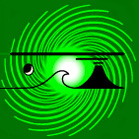


|
|
|
|
|
|
|
|
|
|
 |
 |
 |
 |
||||||
|
||||||||
|
||||||||
This page is part of a paper: Pessi, A., S. Businger, K. L. Cummins, N. W. S. Demetriades, M. Murphy, and B. Pifer, 2009: Development of a Long-Range Lightning Detection Network for the Pacific: Construction, Calibration, and Performance. Journal of Atmospheric and Oceanic Technology, 26, 145-166.
The waveguide between the Earth's surface and the ionosphere allows very low frequency (VLF) emissions generated by lightning, called sferics, to propagate over long distances (Fig. 1). The new Pacific Lightning Detection Network (PacNet), as a part of a larger long-range lightning detection network (LLDN), utilizes this attribute to monitor lightning activity over the central North Pacific Ocean with a network of ground-based lightning detectors that have been installed on widely spaced Pacific islands. PacNet and LLDN sensors combine both magnetic direction finding (MDF) and time-of-arrival (TOA) based technology to locate a strike with as few as two sensors. As a result, PacNet/LLDN is one of the few observing systems, outside of geostationary satellites, that provide continuous real-time data concerning convective storms throughout a synoptic-scale area over the open ocean.
Figure 1. Schematic diagram of the Earth-ionosphere wave guide, which allows VLF (3-30 kHz) emissions from thunderstorms (sferics) to propagate thousands of kilometers through reflection. The best propagation is observed over the ocean at night.
The ionospherically reflected signals have different waveforms than typical ground waves produced by CG lightning return strokes (Fig. 2). Note the sharp initial downward peak and short peak-to-zero time for the ground wave at 264 km (Fig. 2a). At a distance of 860 km, Fig. 2b shows a distinct initial downward ground wave followed by a single-hop ionospheric reflection of opposite polarity (Kelso 1964). At a distance of 3400 km (Fig. 2c), the waveform is determined by multiple ionospheric components, but there is evidence of a very small initial downward ground wave, a slightly larger first-hop (inverted) sky wave (at ~500 µs), and a larger downward second-hop sky wave (at ~520 µs). Although this distant signal contains clear sky-hop components, its overall waveform would be best-described using mode theory (Wait 1996). Since the field produced by a return stroke generally changes polarity at each reflection, the original polarity of the reflected waves cannot be readily determined, unless the ground wave is clearly identifiable.
Figure 2. Vertical electric field waveforms for three different negative cloud-to-ground return strokes detected by sensors located at 264, 860, and 3400 km from the lightning stroke. The amplitude scale is uncalibrated. Black arrows indicate initial appearance of the ground wave and the gray arrows in b) and c) indicate the first-hop and second-hop reflected waves, respectively.
VLF sensors have been installed on several islands in the North Pacific Ocean (Figure 3). PacNet sensors are modified IMPACT ESP (Improved Accuracy from Combined Technology, Enhanced Sensitivity and Performance) sensors designed for long-range detection (Figure 4). The gain has been set to a high level in order to receive weak, ionospherically reflected sferics, and the bandwidth has been adjusted to have greatest sensitivity in the VLF band. The sensors use combined technology that employs both time-of-arrival and magnetic direction finding methods in the data processing (Cummins et al. 1998b).
These Pacific sensors work in combination with other Vaisala Long Range Lightning Detection Network (LLDN) sensors, which consists of National Lightning Detection Network (NLDN) and Canadian Lightning Detection Network (CLDN) sensors located throughout the U.S. and Canada. The ~200 broadband LF/VLF sensors in these networks are not optimized for long-range detection, but still provide important contributions to the overall network performance. The resulting long-range network, hereafter called PacNet/LLDN, continuously monitors lightning activity associated with convective storms across the Pacific Ocean, north of the equator.
Although PacNet sensors are specifically designed for long-range detection, the concept of this long-range lightning detection network is broader than just these sensors, since the processing algorithm also incorporates sensor data from conventional sensors. The long-range location-processing algorithm identifies and accepts sensor data produced by both ground-propagated waves and ionospheric reflections that are rejected by the short-range algorithm used in NLDN and CLDN.
Figure 3. PacNet/LLDN sensor sites
Figure 4. PacNet/LLDN sensors
Acknowledgments: We are grateful to James Weinman for his encouragement to undertake the development of PacNet, to Joseph Nowak for help with detector site selection and installation, and to Nancy Hulbirt for assistance with graphics. This work is supported by the Office of Naval Research under grant numbers N00014-08-1-0450 and N00014-05-1-0551.